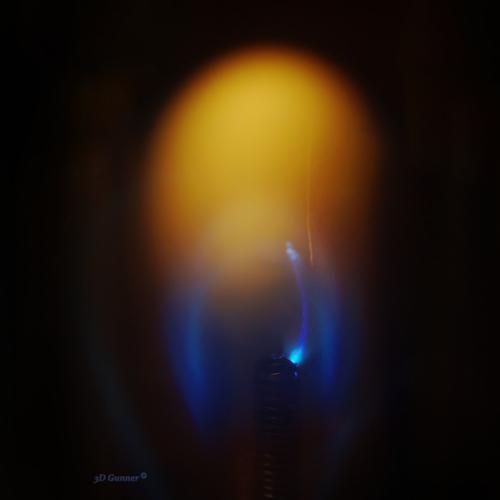Looking forward to seeing more of these.
Thanks,
barondla
-
-
@3DGunner has written:@barondla has written:@3DGunner has written:
The lightning
The electrical discharge that ignites the gas in a piezoelectric lighter.
How did you get the correct timing to capture the spark?
Thanks,
barondlaThe scene was prepared and the lighter fixed, the camera with macro lens on the tripod, manual focus. I set the exposure time to 1s, I did the shutter release with IR remote control in the dark and the ignition was triggered while the shutter was open.
The magnification ratio being high, the DoF is very narrow.Figured you must have taken this in a dark room. One second doesn't give much leeway to get everything synchronized. Appreciate the extra how to info.
Thanks,
barondla -
I determined that one second is the optimal time to obtain the desired result. A shorter time risks not capturing the moment of the electrical discharge. A longer time risks capturing too much light after the flame is lit.
The scene self-illuminates. As a result, you can only adjust the ISO sensitivity after the aperture has been chosen to obtain a reasonable depth of field and for the noise to be within limits that allow its subsequent elimination without compromising image quality. Several attempts are needed, because the electrical discharge does not occur on exactly the same path and the result is not entirely reproducible.
It is the same technique used in the case of lighting the match, except that in that case I left the shutter open for several seconds. -
@3DGunner has written:
I determined that one second is the optimal time to obtain the desired result. A shorter time risks not capturing the moment of the electrical discharge. A longer time risks capturing too much light after the flame is lit.
The scene self-illuminates. As a result, you can only adjust the ISO sensitivity after the aperture has been chosen to obtain a reasonable depth of field and for the noise to be within limits that allow its subsequent elimination without compromising image quality. Several attempts are needed, because the electrical discharge does not occur on exactly the same path and the result is not entirely reproducible.
It is the same technique used in the case of lighting the match, except that in that case I left the shutter open for several seconds.On Olympus cameras there is a mode called "live Composite" that could probably work very well for such a situation.
-
What I did doesn't work like that. What I did requires a single exposure.
What he did in that clip with the function called "Live Composite" can be done with any camera that allows time-lapse, and from a sequence of images obtained through time-lapse, sets of images can be extracted then manipulated in post in any desired combination. -
@3DGunner has written:
What I did doesn't work like that. What I did requires a single exposure.
What he did in that clip with the function called "Live Composite" can be done with any camera that allows time-lapse, and from a sequence of images obtained through time-lapse, sets of images can be extracted then manipulated in post in any desired combination.True, I guess the only difference is that the live composition mode on Olympus does that pp all in-camera and gives a single RAW image as output.
-
@MikeFewster has written:
Venice
Wonderful reflection image with great colors and sinuous forms, (it looks good turned on either side or upside down, too).
-
@3DGunner has written:
So, in the picture are the residues that remain on the matchbox after a match passes by and lights up.😀
Wow, that's impressive. Well done. I'd have guessed it was a gas-lit fireplace being fired up, which was impressive enough.
-
@Woodsider79 has written:
Along the Forest Path
Larch trees in autumn with ICM
Lovely impressionistic capture.
-
-
@Fireplace33 has written:
Just an icicle
but sort of looks somehow abstract :-)
Ice itself seems rather abstract of its own accord. And the closer you get to it, the more abstract it becomes. This seems like a witch's hand...



